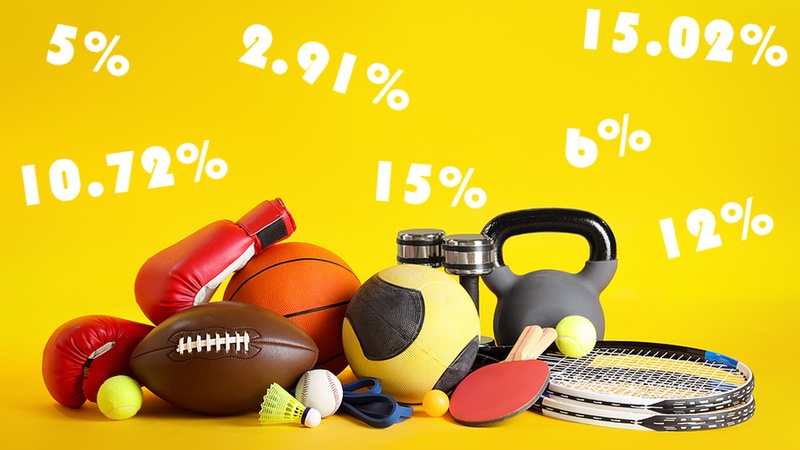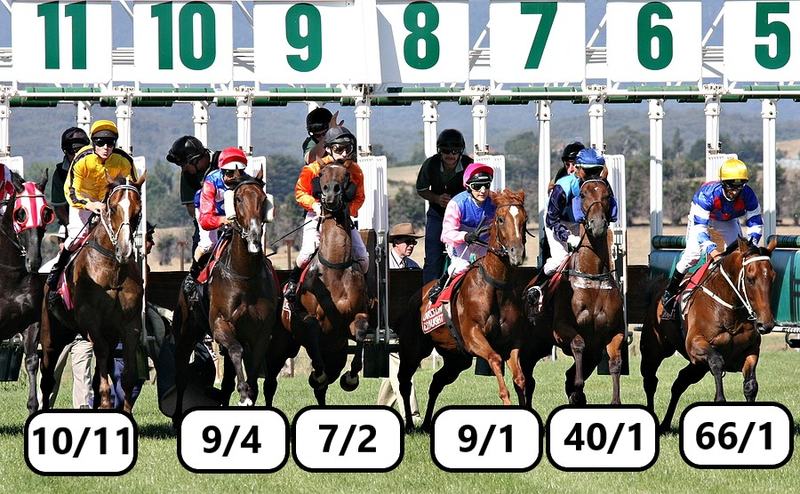 Vigorish is Yiddish slang and originates from the Russian word for winnings and is effectively the bookie’s margin, i.e the charge they apply for their services. Also sometimes referred to as the juice, cut or take, or simply shortened to vig, it is what keeps the bookmakers rich and the rest of us – by and large – not rich.
Vigorish is Yiddish slang and originates from the Russian word for winnings and is effectively the bookie’s margin, i.e the charge they apply for their services. Also sometimes referred to as the juice, cut or take, or simply shortened to vig, it is what keeps the bookmakers rich and the rest of us – by and large – not rich.
The vig is sometimes used interchangeably with overround and whilst the concepts are similar and related, mathematically they are slightly different. Whilst the vigorish is the bookies’ margin, expressed as a percentage of the total stakes, the overround is the percentage by which the book is over 100%, where 100% would equal a fair book (for example where both horses in a two horse race are priced at even money).
Regardless of these technicalities, the easiest way to think of the vigorish is as the bookmaker’s margin. In fixed odds betting this comes from offering odds that do not exactly reflect the probability of each outcome whilst in spread betting it is created by the spread itself.
For example, assuming you are betting on which side will win the toss in a game of cricket, the true odds of either side winning is 50% (as an aside Nasser Hussain lost 14 coin tosses in a row as England captain, the probability of which is one in 8,192). As such you would expect odds of evens, or 2.0 in decimal odds. However, this would leave the bookmakers reliant on luck to make any money, whereas by offering odds of 10/11, or even as little as 5/6, they are able to lock in theoretical earnings over time. I say “over time” because unless they perfectly balance their books (take exactly the same amount of bets on both sides) there is always the chance they could lose in the short term.
How the vig is calculated is quite a philosophical notion, raising the questions of whether the losing or winning bettor pays or whether they both pay and, if the latter, whether they both pay equally. Ultimately it is irrelevant and, as said, the simplest way to consider this is that the vigorish is the bookmaker’s overall financial gain.
How to Calculate the Bookies’ Margin
 As noted above, the vigorish and overround are subtly different. Whilst the title of this article uses the word vigorish, it is far more common for punters, comparison sites and tipsters to focus on the overround and that is what we will do here.
As noted above, the vigorish and overround are subtly different. Whilst the title of this article uses the word vigorish, it is far more common for punters, comparison sites and tipsters to focus on the overround and that is what we will do here.
For the sake of clarity, the vigorish is, quite specifically, the profit a bookie makes on an event expressed as a percentage of the total stakes on that market or contest. That said, there are different usages where it can be calculated differently, which is another reason why looking at the overround can be favoured.
The overround shows us at any one moment in time (it is calculated based on odds, which of course change, so the overround changes too) what sort of margin the bookie is operating on a market. It does not show us profit, because that would depend on knowing the overall stakes on each side of the bet, how the prices changed during the course of the betting, and which selection won. However, it is by far the quickest and simplest way to see whether a bookie is offering “good” or “bad” odds.
The first step to working out the overround is to calculate the implied probability for each outcome. If there are seven horses in a race, it would be for each of the seven runners, whilst for football match odds, it would be for the home win, the draw, and the away win. Implied probability can be viewed as odds turned into the percentage chance of that pick winning.
To work out the implied probability you take the decimal odds for each pick and divide 1 by that number. Let us consider perhaps the most popular market in all of betting: 90-minute match odds in football. If the home win is 1.70 (7/10), the draw is 3.90 (29/10) and the away win is 4.20 (16/5), your implied probabilities would be:
- 1 divided by 1.70 = 0.58823 = 58.82%
- 1 divided by 3.90 = 0.25641 = 26.64%
- 1 divided by 4.20 = 0.23809 = 23.81%
Adding those together gives you what some people will call the overround but is more accurately the “book”. In this case we have a book of 109.27% (58.82+26.64+23.81) and the amount by which this exceeds 100 is the overround. As such, based on the odds detailed, this bookie is operating with an overround of 9.27%.
This 9.27% overround acts as their margin and serves to allow them to make money but it is not the actual gain itself. How much the bookie makes will, of course, depend on the exact breakdown of the bets made but it is the fact that these prices are lower than they “should” be that facilitates the bookie making money at all.

Returning to the coin toss mentioned above, if a bookie did offer odds of evens on both outcomes, the book would be exactly 100%, with no overround. That is because evens is 2.00 in decimal, and 1 divided by 2 is 0.5. Add the two outcomes, heads and tails, or in cricket one side winning the toss or the other doing so, and you have 50% + 50%. A perfect 100% book with no margin for the bookie.
Let us return to our game of football and look at the odds offered by another bookie. Perhaps they go 1.75 for the hosts, the same 3.90 for the draw and a lengthier 4.50 for the away win. How does that compare? Clearly if you want to bet on the home team, the odds are shorter, whilst the draw is the same and the away team is available at bigger odds. But which bookie offers better odds on the entire market?
In a practical sense the question is moot. If you want to back the hosts you use the first bookie, if you want to bet on the underdogs, you use the second. But what if you want to know which bookie has the best odds in general, in order to choose which to use regularly?
Well, with the new odds we see the following equations:
- 1 divided by 1.75 = 0.57142 = 57.14%
- 1 divided by 3.90 = 0.25641 = 26.64%
- 1 divided by 4.50 = 0.22222 = 22.22%
So the second betting site is operating a book of 106% and thus an overround of 6%. Deciding one bookie had better odds than another based on checking one market would be foolish. However, if you checked a good number, across all the sports and different types of bets you liked to make, you could begin to draw a firmer conclusion. If you found that in the majority of cases the overround was smaller with the second site, then maybe they would be the ones to consistently offer better value.
How Much Vig Do Bookies Add?

The vig, or overround (to use the terms interchangeably), a bookie adds varies in myriad different ways. Different bookies operate with different margins, some offering generous odds, others being less rewarding. Some sports and leagues will tend to have wider margins too, whilst even within those same sports, you will see different margins according to the specific market.
More complicatedly, whilst we cannot be certain, nor really measure it, the load of the margin is not spread evenly across all the possible outcomes in any given market. By this, we mean that there is a good chance that odds are not set simply by reducing all prices by a small percentage from what the bookie believes the true prices should be. Instead, as a general rule, there is less margin on selections at the head of the market – the favourites – and more on outsiders.
It is hard to be sure about matters such as this as, aside from simplistic bets like cricket’s coin toss, nobody knows what the true probability of any event is. What we can measure more clearly is how the vig varies between different sites, sports and markets. If we return once more to our football match, we have seen that one site had an overround of 6% and another had one in excess of 9%.
Let us look at a third site. This bookie has the favourite at 1.66, the draw at 3.75 and the away win at 4.20. Based on these odds this bookmaker ranks the worst of the three, with an overround of 10.72%. These sorts of figures are fairly typical given this was the match odds of a big game between two sides from the English Premier League. You can expect to find an overround of somewhere between 5% and 12% for a market like this, the the difference between bookies can be huge.
However, if we look at the match odds for a game in the Salvadoran Primera Division, we see that the overround is higher. 10% to 15%, or even 20% is more common, chiefly because the bookies are less confident that their assessment of the game is accurate. Football in Salvador attracts far fewer wagers and so they invest less time and effort in making sure their odds are a good representation of the true probabilities. By posting prices with a larger overround, they give themselves more margin for error in the event that they get things slightly wrong.
Sticking with football, we can see an even higher overround in the correct score market. In football terms, this market is generally considered to offer the worst value, with an overround of at least 120% and sometimes as much as 160%.
At the other end of the spectrum, footballing Asian handicaps, or bets that operate in the same way, are often the market with the lowest overround. Such markets are very common in US sports where, one way or another, there is a simple binary choice between teams. If we look at the moneyline odds (a two-way market at this stage settled on whoever progresses) for the Championship games we can see just how small the overrounds were.
In the NFC the Eagles were 1.69 and the 49ers 2.25 for an overround of just 3.62%. In the AFC Championship match the Kansas City Chiefs faced the Bengals. There the Chiefs were 1.89 and the outsiders, just, were priced at 2.00: an overround of 2.91%.
What Factors Impact the Vig or Overround?

As we have seen, the overround can vary significantly between different bookies, sports and markets. There are many reasons for this, often more than one combining to explain why the margins can vary so wildly.
Below is a summary of the most important factors to think about:
- Bookie resources and choice – the simplest explanation is that the bookie simply chooses to offer generous or less generous odds. They may want to attract new customers or top comparison sites, so offer, for a while at least, very good odds. Alternatively, they may lack the funds to be confident in their odds setting, or to take a hit when they get things wrong, and so operate with a wider margin instead.
- Popular sports and markets – the sports and markets that attract the most stakes will usually have the tightest margins (smallest overround). This is because bookies are keener to be competitive when millions of pounds are being staked than when just a few hundred are.
- Niche sports and leagues – this is partly the same point as above but in reverse, but the English Premier League will generally have better odds than Bolivian football; the match odds in football will generally have more competitive prices than odds on first-half corners; and football generally will have a smaller overround than sailing (overall). Two factors, already touched on, are at play. First, the bookie wants to be more competitive when more cash is on the line. Second, the stranger, weirder or more niche the sport is, the greater the chance that its followers know more about it than the bookie’s oddsmakers. As such, they are at risk of being hit by people who can spot when their odds are out of line, meaning they give themselves more wiggle room through a larger overround.
- Simple bets have a lower overround – studies have shown that most humans have a very poor grasp of probability at the best of times. However, the more complex the equation, the worse that gets. So the simpler the bet, say over or under 2.5 goals, the more likely a punter is to understand whether or not that bet offers value. A complex wager, like a bet builder with 10 legs, is just too difficult to calculate and so a punter has no real idea whether good value is 100/1 or 500/1. As such, bookmakers can offer poor odds and create markets with vast overrounds.
- Fewer selections to choose from – in many ways the same point as the one made above, humans can also better understand odds and probabilities when they are faced with just two or three options. This partly explains why Asian handicaps have low margins. Calculating the fair odds in a correct score market, with 10, 20 or even more options is beyond most of us. The right odds of a 4-4 draw might be 500/1 but few punters who fancy such a score would be able to spot that and see that the 200/1 offered was terrible value.
Do Bookies Always Try to Balance Their Books?
 The fact that bookies offer odds below the fair ones is virtually identical to the way a shop buys a table at one price and then sells it on for more than it cost them.
The fact that bookies offer odds below the fair ones is virtually identical to the way a shop buys a table at one price and then sells it on for more than it cost them.
Everyone accepts that enterprises, be they bookmakers, table shops or anything else, need to make a profit. However, there is a big difference between most shops and the world of gambling. If a retailer sells a table they bought for £100, for £200, they know they will be in the black. Things are rather different with a bookmaker.
Whilst their odds factor in a profit margin due to the vig, or overround, it is still possible that they can lose money on a match, race or event. Indeed, it is not all that uncommon to read headlines about bookies losing millions at Cheltenham, or other big race meetings, or on major events like the Premier League in football.
This is because bookies rarely operate with a perfectly balanced book and so if results go against them, they can, will and do lose.
What is a balanced book?

The coin toss in cricket is the simplest market to use as an example to demonstrate how a balanced book works. There is a 50% chance the home side wins and a 50% chance the away team do. The true odds for both would be evens but due to the vig bookies might offer 4/5 (thus giving a book of 111.11% and a very bookie-favourable 11.11% overround).
A balanced book would see them take exactly the same value of bets on both outcomes, for example £10,000 on each. In such a scenario, come what may, they will take in £20,000 of bets, return £10,000 in successful stakes, £8,000 in winnings and keep £2,000 for themselves. No matter who wins the toss, they are £2,000 to the good.
In general bookies like to keep a book that is broadly balanced and they adjust their odds to this end. Let us move away from a coin toss and look at a Champions League final between two very evenly matched sides, where both are priced at 10/11 to lift the trophy. If a bookie starts receiving a lot of money on Team A and none on B, they will reduce the odds of A and increase those of B. Now B are the more attractive proposition and they start seeing wagers on them with the aim that, come kick-off, no matter which side is victorious, they are in the black.
However, for a range of reasons, achieving a perfectly balanced book, or even an approximately equal one, is either not possible, or not desired. In days gone by it was common for this to be down to a bookie “taking a position”. By this, we mean that the bookie felt a particular team, horse or player was far more fancied by the market, the masses, than by their odds-setting team.
In such a scenario the bookie may be happy to continue offering decent odds on a selection, even though they will lose overall if it wins. The bookie has decided the risk is worth it, and that the huge take they will achieve if that pick doesn’t win means accepting a loss if it does is a good gamble.
In modern times, where bookies are huge corporations, rather than one-man-bands or family businesses, taking a position is less common. Bookmakers are far more technology-driven, using data, algorithms and computing power to aim for a balanced book, or close enough, the vast majority of the time.
However, despite this there are still times when they lose. This is chiefly when lots of favourites win. For example, the article linked to above concerned the 2016 Cheltenham Festival where “nine favourites and one joint favourite won in the 28 races over four days”. When a much-loved (and heavily backed) jolly wins the Grand National, such as Red Rum in the 1970s or more recently Tiger Roll, the bookies also tend to feel the pain. In addition, it is also common for bookies to take a hit when there are lots of home wins on a weekend of football, or lots of goals; and in particular when all the “big” teams (the two Manchester clubs, Chelsea, Arsenal, Liverpool and Spurs) win on the same weekend.
Many punters believe that winners at long odds hurt bookies as they create high payouts but in fact the opposite is true. As we have said, their margin tends to be big on these bets and whilst the odds are long, few punters back massive outsiders. Favourites tend to be the most popular call in all markets and sports. This makes sense as, more or less by definition, they are the selections most likely to win.
If a bookie wanted they could slash their odds so dramatically that nobody would choose to back that team, player or horse with them. By inflating their prices on the favourite’s rivals they could probably achieve a book that left them in the black most of the time, no matter who won.
However, this would run the risk of them being seen as uncompetitive on the biggest sports and matches, in particular on the selections that most punters want to back. In the long run, this could see punters start to make most of their bets elsewhere. This could certainly cost them far more money than the occasional hit on the rare occasion when lots of well-backed selections do the business.
For this reason most betting sites do not tend to go all out for a balanced book all of the time. Once or twice during the football season they may have to pay out on hundreds of decent accumulators covering the most fancied teams. But overall, the vig softens the blow a little bit anyway, even then, and more importantly, the overround on all of their bets means that more often than not they are the ones counting their winnings, not us punters.
